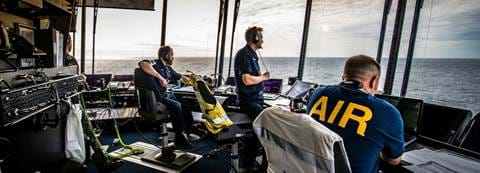Chelton boards HMS Queen Elizabeth
Much like Her Majesty herself, HMS Queen Elizabeth travels with an entourage made up of aircraft and vessels kitted out with with Chelton antennas and avionics.

The Royal Navy calls it the most powerful UK naval flotilla in a generation as it set sail in June on its first operational deployment following a visit from the UK Prime Minister and the ship’s namesake, Queen Elizabeth II herself. The fleet has now embarked on a world tour – set to cover 26,000 miles in 28 weeks. During its journey, the Queen Elizabeth Carrier will travel to the Mediterranean to conduct airstrikes over Iraq against ISIS after which it will sail down the Suez Canal before making a number of port stops in East Asia.


Much like Her Majesty, HMS Queen Elizabeth travels with an entourage known as the Carrier Strike Group. Consisting of ten vessels from armed forces across the globe, including the warships HMS Defender and HMS Diamond, it truly is a naval force to be reckoned with – supported by a diverse host of aircraft, including 24 F-35B Lightning combat jets, Chinook Helicopters and 802 Naval Air Squadron’s complement of Merlin Mk2 helicopters.
Crucial throughout the Strike Group’s operations will be planning, communication and management of the aircraft stationed on board the QE Class Carrier. The aircraft on-board will be participating in a number of combat and anti-piracy training all of which will require precise management and direction of Lightning fleet on-board. Communication between the assortment of air platforms and naval vessels, as well as air traffic control back on shore, will be a clear necessity for the entire fleet both in day-to-day operations and during the crucial training and combat exercises it will carry out. Luckily, we’re on board to help.


The HMS Queen Elizabeth (R08) is fortified with Chelton’s own revolutionary, one-of-a-kind shipborne radar display system – the RDSFleet suite. Designed to translate the regulations and features of a land-based air traffic control system to the complex naval environment, RDSFleet boasts a highly adaptable Arrival Management system with the ability to accommodate the full breadth of carrier-based air platforms – from vertical-landing aircraft such as the F-35B, to rotorcraft like the Merlin Mk2s and Chinooks. All of which form part of the Carrier Strike Group. And it doesn’t end there. Even after take-off, RDSFleet’s Moving Map Radar Display and Safety Net Processing modules will convey the support teams back aboard with a host of valuable data including altitude warnings, conflict alerts, and a virtual ‘airfield’ showing the naval environment the aircraft are operating in. Before the pilots have even taken suited up or their seats, RDSFleet will have proved its worth in the pre-flight stage through the wealth of global flight planning data it provides.
Connecting between air, ship and shore has never been easier thanks to the universal communications systems pioneered by Chelton. Air Traffic Controllers, whether they are based at a tower on land or in the middle of the ocean, can talk to anyone, anywhere, through the same system – even the user experience and displays are identical! The proof is in the pudding and throughout the Carrier Strike Group’s multi-year campaign, the fleet will be supported by our exceptional and unique systems; from Air Traffic Control Systems to antennas, anti-jam and directional finding systems.

For more detailed information on our ATC capabilities, get in touch.
Your quote basket is currently empty
 Please select the type of quote you require for this product:
Please select the type of quote you require for this product: